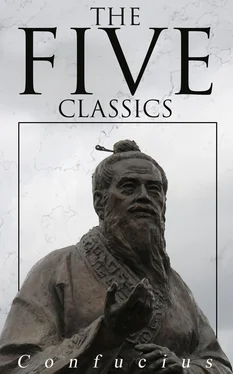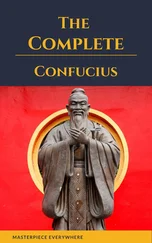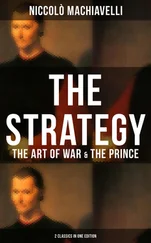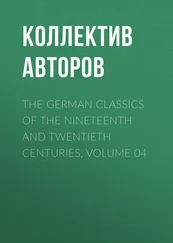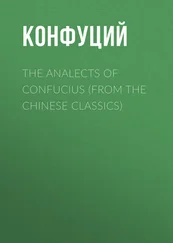Line 4, though weak, is in its correct place, and adjoins the strong 5, which is in the ruler's seat. The subject of 4, therefore, will fitly represent the minister, to whom it belongs to do a great part in remedying the evil of dispersion. And this he does. He brings dissentient partizanship to an end; and not satisfied with that, he collects multitudes of those who had been divided into a great body so that they stand out conspicuous like a hill.
Line 5 gives us the action of the ruler himself;--by his proclamations, and by his benevolence. K û Hsî and other critics enlarge on the symbolism of the perspiration, which they think much to the point. P. Regis avoids it, translating--'Ille, magnas leges dissipans, facit ut penetrent(ur?).' Canon McClatchie has an ingenious and original, so far as my Chinese reading goes, note upon it:--'As sweat cures fevers, so do proclamations cure rebellions.' Both of these translators miss the meaning of the other instance of the king's work.
Line 6 is occupied by a strong line, which has a proper correlate in 3; but 3 is at the top of the trigram of peril. The subject of 6 hurries away from association with the subject of it, but does so in the spirit of the hexagram, so that there is no error or blame attaching to him.
Table of Contents

K ieh intimates that (under its conditions) there will be progress and attainment. (But) if the regulations (which it prescribes) be severe and difficult, they cannot be permanent.
1. The first line, undivided, shows its subject not quitting the courtyard outside his door. There will be no error.
2. The second line, undivided, shows its subject not quitting the courtyard inside his gate. There will be evil.
3. . The third line, divided, shows its subject with no appearance of observing the (proper) regulations, in which case we shall see him lamenting. But there will be no one to blame (but himself).
4. The fourth line, divided, shows its subject quietly and naturally (attentive to all) regulations. There will be progress and success.
5. The fifth line, undivided, shows its subject sweetly and acceptably enacting his regulations. There will be good fortune. The onward progress with them will afford ground for admiration.
6. The topmost line, divided, shows its subject enacting regulations severe and difficult. Even with firmness and correctness there will be evil. But though there will be cause for repentance, it will (by and by) disappear.
60.The primary application of the character K ieh was to denote the joints of the bamboo; it is used also for the joints of the human frame; and for the solar and other terms of the year. Whatever makes regular division may be denominated a K ieh; there enter into it the ideas of regulating and restraining; and the subject of this hexagram is the regulations of government enacted for the guidance and control of the people. How the constituent trigrams are supposed to suggest or indicate this meaning will be seen in Appendix II.
K û Hsî anticipates that symbolism in trying to account for the statement that the figure gives the promise of success and attainment; but the ground of this is generally made out by referring to the equal division of the undivided and divided lines and our having in 2 and 5, the central places, two undivided lines. An p. 199 important point concerning 'regulations' is brought out in the conclusion of the Thwan,--that they must be adapted to circumstances, and not made too strict and severe.
Line 1 is strong, and in its correct place. Its subject therefore would not be wanting in power to make his way. But he is supposed to be kept in check by the strong 2, and the correlate 4 is the first line in the trigram of peril. The course of wisdom therefore is to keep still. The character here rendered door is that belonging to the inner apartments, leading from the hall into which entrance is found by the outer gate, mentioned under line 2. The courtyard outside the door and that inside the gate is one and the same. The 'Daily Lecture' says that the paragraph tells an officer not to take office rashly, but to exercise a cautious judgment in his measures.
Line 2 is strong, in the wrong place; nor has it a proper correlate. Its subject keeps still, when he ought to be up and doing. There will be evil.
Line 3 should be strong, but it is weak. It is neither central nor correct. It has no proper correlate, and it is the topmost line in the trigram of complacent satisfaction. Its subject will not receive the yoke of regulations; and he will find out his mistake, when it is too late.
Line 4 is weak, as it ought to be, and its subject has respect to the authority of the strong ruler in 5. Hence its good symbolism and auspice.
Line 5 is strong, and in its correct place. Its subject regulates himself, having no correlate; but he is lord of the hexagram, and his influence is everywhere beneficially felt.
Line 6 is weak, in its proper place. The subject of the topmost line must be supposed to possess an exaggerated desire for enacting regulations. They will be too severe, and the effect will be evil. But as Confucius (Analects 3. 3) says, that is not so great a fault as to be easy and remiss. It may be remedied, and cause for repentance will disappear.
Table of Contents

K ung Fû (moves even) pigs and fish, and leads to good fortune. There will be advantage in crossing the great stream. There will be advantage in being firm and correct.
I. The first line, undivided, shows its subject resting (in himself). There will be good fortune. If he sought to any other, he would not find rest.
2. The second line, undivided, shows its subject (like) the crane crying out in her hidden retirement, and her young ones responding to her. (It is as if it were said), 'I have a cup of good spirits,' (and the response were), 'I will partake of it with you.'
3. The third line, divided, shows its subject having met with his mate. Now he beats his drum, and now he leaves off. Now he weeps, and now he sings.
4. The fourth line, divided, shows its subject (like) the moon nearly full, and (like) a horse (in a chariot) whose fellow disappears. There will be no error.
5. The fifth line, undivided, shows its subject perfectly sincere, and linking (others) to him in closest union. There will be no error.
6. The topmost line, undivided, shows its subject in chanticleer (trying to) mount to heaven. Even with firm correctness there will be evil.
61. K ung Fû, the name of this hexagram, may be represented in English by 'Inmost Sincerity.' It denotes the highest quality of man, and gives its possessor power so that he prevails with spiritual beings, with other men, and with the lower creatures. It is the p. 201 subject of the 'Doctrine of the Mean' from the 21st chapter onwards, where Remusat rendered it by 'la perfection,' 'la perfection morale,' and Intorcetta and his coadjutors by 'vera solidaque perfectio.' The lineal figure has suggested to the Chinese commentators, from the author of the first Appendix, two ideas in it which deserve to be pointed out. There are two divided lines in the centre and two undivided below them and above them. The divided lines in the centre are held to represent the heart or mind free from all pre-occupation, without any consciousness of self; and the undivided lines, on each side of it, in the centre of the constituent trigrams are held to denote the solidity of the virtue of one so free from selfishness. There is no unreality in it, not a single flaw.
Читать дальше
